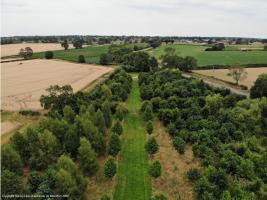Club Meeting - Peering into the earliest galaxies
Wed, Feb 28th 2024 at 6:00 pm - 7:30 pm
Speaker Prof. Nial Rahil Tanvir is a British astronomer at the University of Leicester. His research specialisms are the Extragalactic distance scale, Galaxy evolution and Gamma ray bursts.

Club members please log in for more information.
Speaker: Professor Nial Tanvir, Peering into the Earliest Galaxies with the James Webb Telescope
As you may imagine the talk was as complicated as the title! Professor Tanvir took us for several thought provoking journeys back and forth through time, answering many questions but evoking many more!
He began by comparing the Hubble Telescope with the James Webb Telescope. Images showed they look quite different both in size and construction design. The Hubble scope was launched in 1990 and orbits the earth at a relatively low height. The James Webb scope, launched in 2021, is in deeper space and orbits the sun near the second Lagrange point - these points are where the gravitational force between two bodies is in equilibrium. L2 enables clear views into deep space. The mirror on the James Webb is larger than the Hubble, 6.6 metres and 2.4 respectively. The James Webb mirror is coated in gold and a sun shield keeps the telescope cold. The James Webb looks more like a satellite. The kinds of light the telescopes look at are different with the James Webb operating in the infra-red (IR) range.
There are various reasons for operating in the IR range. In places space is full of dust - not like dust on the surfaces at home, but small particles of smoke size that are rather tenuous. The James Webb
can better see through this dust, demonstrated by 2 similar images of nebulae produced by both, James Webb giving better views of more distant galaxies.
We explored what a galaxy actually is. Our ‘local’ galaxy is the Milky Way and as we are part of it we cannot see the whole make-up. Some galaxies, like the Milky Way, are spiral in structure and are illuminated by over a 100 billion stars. The stars, dust, gases and black matter are bound together by gravity. We have only understood the Milky Way for 100 years and know that it is spread over a huge distance - 100,000 light years (ly) which, in earth terms, is around a billion, billion kilometres!
Edwin Hubble is famous for working out distances in space. He saw other spiral structures and nebulae (the resultant gas and dust of an exploding, dying star), which looked like cities of stars. Andromeda, for instance, can be seen by binoculars. It is 2.5 million light years away from us. Hubble knew the smaller structures were further away and deduced the universe must be vaster than our galaxy. We now know the universe is filled with many galaxies. We can look far, far away pointing away at one spot for days at a time and we can also look deep into a tiny patch, 1 tenth the size of the full moon - a pencil beam into the universe to see many more galaxies. It is thought there are in excess of at least 100 billion galaxies.
Edwin Hubble’s next big discovery was redshift. He looked at distance galaxies and, using spectrography, he produced spectrograms of the light from the stars. On the resultant spectra he saw bright and dark lines - glowing nebulae and cold gas shining through respectively. These effects correspond to particular elements. On the various spectra produced, the same line patterns were seen but they were in different places. All those shifted to the red end must be moving away from us very quickly (the red end of the spectrum demonstrates longer wavelengths) with expanding wavelengths due to distance, resulting from speed. The further galaxies are moving away faster. This could be said to be the discovery of the expanded universe. It allows us to map out the universe over larger distances - as we stand we see everything moving away from us.
Light years are measured by the time it takes the light from a distance body to reach us which, therefore, means we are looking into the past when earth was forming. This in turn leads us to an understanding of the universe and evolution as different stages of cosmic history……… Far away means long ago with the age of the universe. The James Webb is now probing space at redshift 10 which is deemed to be the frontier towards the Big Bang. The greater the redshift number the further away we are looking.
Nial showed us many images throughout the talk to illustrate structures, graphs and other information.
We looked at a galaxy cluster. A galaxy cluster is, as it infers, a cluster of galaxies that form in parts of the universe. Larger galaxies are often central to the cluster with smaller ones further out. Nial talked about the various elements and the presence of dark matter. Gravitational lensing can be used to see further back in time. This lensing gives a distorted but magnified view. Images demonstrated this from the Hubble and the James Webb telescopes. The James Webb has the advantage in this because of the infra red capability but Hubble, being older, has produced more information than the James Webb, only in operation for 2 years. The James Webb telescope gives more information from a different perspective and is good for looking at the most distant galaxies; looking in the infra-red gives us a view of what would be the optical view, if we were there.
The advantage of the James Webb is the ability to study the clusters with lensed images. We were introduced to the Earendel effect. Earendel is an individual star within a cluster that has aligned with part of the lens causing greater magnification. The star then appears bright enough to be seen although optically small in size due to it’s great distance from us. Earendel is arguably the most distant star ever found.
What is the most distant galaxy? Nial has held the record with one exploding star but the record has since been broken with the James Webb telescope showing evidence of more distant stars more frequently. Nial’s area of expertise is looking at exploding stars - supernova are dying stars. We were shown images which demonstrate the most distant stars, deep in space. The evidence comes from the spectra showing a step in light where it reaches the redshift frontier. How much further can we push to be before the first galaxy……
Images of very distant lensed supernova showed curved light of gravitational lensed galaxies. The most distant supernova are very bright and seen on multiple images.
Our next subject was the most distant quasar (extremely luminous centre of a galaxy powered by a black hole) Quasars are important in identifying black holes. The James Webb can see back to within 500 million years after the Big Bang. A schematic showed from the Big Bang there is a smooth universe before the formation of structures over time. Black holes have gases swirling around them and these allow measurement of the black hole by the speed of the swirling matter. The Milky Way has a black hole in it’s centre. We were reassured it is hard to fall into a black hole as it is relatively very small - no need to worry about being sucked in!
Nial moved on to talk about the time-line of the universe which he illustrated on screen. The time-line, from present day back to the Big Bang, was a logarithmic scale. When looking back in time we looked at different cosmic ranges. We specifically looked at the period of re-ionisation which followed the dark age. After the Big Bang gases cooled down over time and the gases between galaxies ionised which takes a lot of energy. Most of the matter is between galaxies and is all ionised. When early stars form they emit ionising radiation. The universe was re-ionised by gamma ray bursts (exploding stars). The James Webb telescope is particularly good at quantifying hidden galaxies enshrouded by gas. There have been many papers on gas shrouds and their reduction allowing re-ionisation.
Robin asked about the projection of the universe going forward. Nial assured us it would carry on for a long time (10s of billions of years), becoming more expanded, getting cooler with lower and lower density. Future scientists will not be able to see much beyond the immediate. We learnt the James Webb telescope was funded mainly by NASA with others contributing. Leicester, for instance, built one of the instruments on board. The European Space Agency has also contributed. Big costs are spread over long periods of time, over many countries. We talked about if we were to stand at the edge of the known universe what would we see? Nial explained we would see the observable universe and then the cosmic dark ages, followed by the hot gas of the Big Bang as it glowed but we would see no further. We can infer a boundary would be reached eventually. In short, what happens at the edge is the beginning of time…….
Nial told us he receives an alert on his phone, regardless of the time of day, when a gamma ray burst is recorded by a satellite. He then has to decide whether it is an important occurrence or whether it is something to ignore. I guess we were never going to get away without reference to Star Trek and warp drives which wound up the discussions!
Malcolm thanked Nial, on behalf of the Club, for spending time with us and exploring with us his knowledge of space. We learnt new words and phrases such as redshift, so thank you.
'What We Do' Main Pages:
Venue .Loughborough University.
more
Located on the A5199 Welford Road, between Foston Rd and Arnesby, The entrance location ///crew.broad.branch. SEE DETAILS BELOW...
more.jpg)
.The club continues to undertake a varied and active involvement with environmental projects - NEXT WORK PARTY DATE = 18th March 2024
more
.Club President Stuart accompanied by Rotarian LInda, visited Knighton Mead Academy on 3rd March, to present Young Writer Awards.
more




